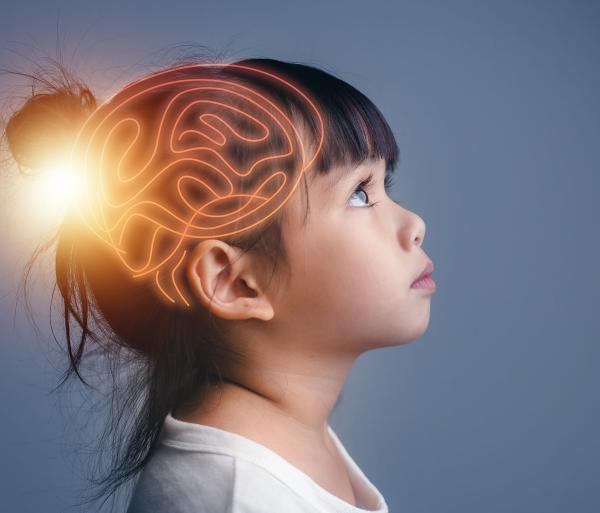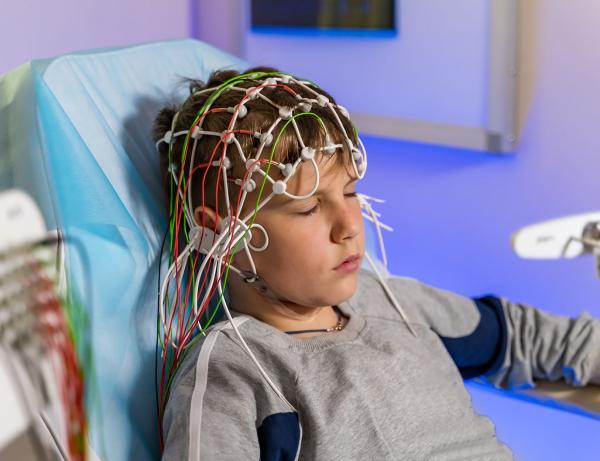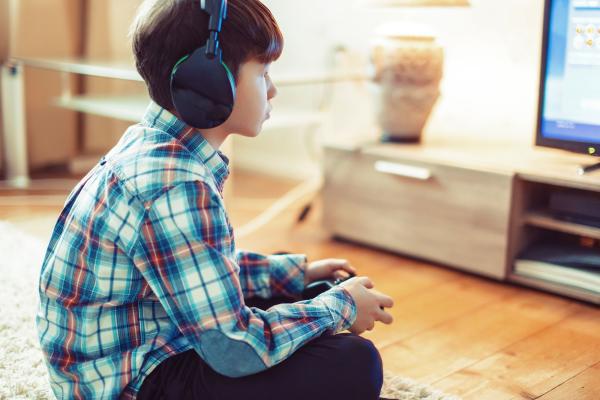Calming Kids’ Runaway Emotions
Brain Research Helps Understand and Treat Childhood Anxiety

IRP researchers are peering at the brains of pediatric patients to help them deal with excessive anxiety and other emotional issues.
It’s perfectly normal for young children to throw tantrums or be nervous on their first day of school, and for adolescents to be anxious about what their peers think of them. However, for some children and teens, negative emotions can escalate to unhealthy levels, resulting in significant distress and impairing their quality of life.
IRP senior investigator Daniel Pine, M.D., is on a mission to understand how that happens and figure out ways to help those kids. In honor of Mental Health Month, we talked with Dr. Pine about how his research is revolutionizing the field of pediatric psychiatry and paving the way for new, non-pharmaceutical treatments.
“Ultimately, we want to use this information to help children,” Dr. Pine says, “so we’re trying to come up with new ways to help kids who are struggling, but we’re also thinking about prevention and what we can do to help kids who might be at risk and their families.”
Dr. Pine’s path to studying emotions in children wasn’t a straight line. He initially planned to be a pediatrician, since he was drawn to the idea of helping kids with the health problems that affect them most. He soon realized that mental health issues were a major, often overlooked challenge.
“I came to the idea that our limited understanding about brain development was a major impediment to better understanding the differences between healthy and not healthy emotions,” Dr. Pine says.

Dr. Daniel Pine
That realization led him to join the National Institutes of Health in 2000, where he could combine his clinical experience with the cutting-edge neuroscience work being done in the NIH IRP. Dr. Pine’s early work there played a key role in changing how we view anxiety in children.
“In the 1980s and early 1990s, anxiety was often seen as a normal part of childhood, and it was not seen as a particularly helpful phenomenon on which to focus,” he explains. “Now, of course, that’s changed a lot.”
Dr. Pine’s studies combine numerous methods to give a comprehensive view of what is happening in the brains and bodies of children with anxiety or other emotional problems. For example, data from magnetic resonance imaging (MRI) scans and electroencephalography (EEG) shows what is going on in kids’ brains and can reveal information about how differences in brain structure might be related to emotions. Meanwhile, tools that detect where children look during a task can tell researchers about what they pay attention to, and measuring automatic nervous system responses like changes in heart rate or sweating can show how the body reacts to certain experiences. Dr. Pine’s lab employs these techniques while its pediatric participants engage in activities designed to elicit a conscious or even unconscious emotional response.

Dr. Pine’s research employs neuroscientific technologies like the electroencephalogram (EEG) pictured here, which uses electrodes placed on the head to detect brain activity.
The information that results from such experiments can shed light on the boundaries between healthy, adaptive emotions and emotions that interfere with kids’ daily lives. For example, we all have a fight-or-flight response that warns us of approaching danger, but when this system goes into overdrive, it can trigger the same symptoms in safe situations, like going to school or taking a test, as it does when there is a true threat. Learning the biological reasons why a kid’s automatic response system has become trigger-happy can guide the development of treatments.
Dr. Pine is particularly interested in any interventions that might not require the use of drugs like antidepressants or anti-anxiety medications. Instead, his efforts focus on helping children learn to steer their runaway emotional reactions, even when they’re not aware of what or why something triggers a fearful reaction. Interventions that re-train those automatic processes can help kids better control them.
Among the innovative treatments Dr. Pine’s lab is trying are video games designed to change how and what kids pay attention to. These games aren’t just for fun; they’re carefully designed to target specific brain functions and help children manage their emotions more effectively.

One of the interventions Dr. Pine’s lab has developed are special video games that help kids learn to focus their attention in ways that reduce their anxiety.
“Depending on the problems that the individual is having, we train different things,” he explains. “Kids with anxiety tend to dwell for an inappropriately long time on threatening stimuli, for example. To help them reduce that anxiety, we train them to focus their attention on positive stimuli and to not dwell on threats.”
Dr. Pine’s research has also made headway into understanding how children make decisions and what that can tell us about their risk for future anxiety or depression.
“Right now, we’re not great at predicting which kids will grow up and be fine and which kids will not do so well, and we’ve reached a point where the clinical variables that we can measure directly can only take us so far,” Dr. Pine says.
That’s why he and his research team are using neuroscientific techniques like MRI and EEG to look at kids’ brain functioning as they grow up. For instance, in one study, Dr. Pine’s team found that 14-month-old infants that exhibited high levels of fearful or cautious behavior when exposed to unfamiliar objects or situations showed signs of higher anxiety during EEG tests at age 15 when they gave incorrect responses while performing decision-making tasks. When Dr. Pine’s team saw these same participants as young adults, they found that those with greater fear as infants generally grew up to be more introverted and anxious.1
“The brain registers errors far too quickly to be monitored clinically, and people aren’t aware of their own brain’s response,” Dr. Pine says. “However, it turns out that people who have anxiety have a particularly robust brain response to errors when we measure their brain activity.”
Conducting scientific research that involves children and teens is tricky, Dr. Pine notes. Their issues can be difficult to diagnose and solve, and it’s necessary to strike a balance between helping children address their emotional difficulties and protecting them and their families from any negative experiences that could come with treatment.
“You have to take the time to really engage the families, and you have to be quite creative,” Dr. Pine says. “You have to do things during the studies that kids will find enjoyable and will want to do. You have to be eager to involve kids and families in the work we’re doing and to listen to their concerns and their preferences, and you have to give back to them.”
Fortunately, Dr. Pine’s approach to walking that tight rope seems to be proving fruitful for the children and families he works with.
“Virtually every single family that we’ve seen — they have just been wonderful,” Dr. Pine says. “I’m still stopped by people when I’m out who thank us for our work.”
Subscribe to our weekly newsletter to stay up-to-date on the latest breakthroughs in the NIH Intramural Research Program.
References:
[1] Tang A, Crawford H, Morales S, Degnan KA, Pine DS, Fox NA. Infant behavioral inhibition predicts personality and social outcomes three decades later. Proc. Natl. Acad. Sci. U.S.A. Apr. 2020; 117 (18):9800-9807. doi: 10.1073/pnas.1917376117.
Related Blog Posts
This page was last updated on Monday, May 19, 2025
